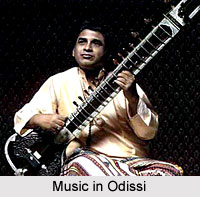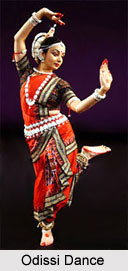 Odissi is believed to be oldest form of Indian dance according to the various sculptural evidences available. Temples has been the basis of cultural life in this state therefore Odissi dance has been closely connected with their routine activities. Odissi dances show signs of Buddhism, Tantrism, Shaivism, and Vaishnavism. In Natyashastra it is referred to as Odhra Magadhi. It has been differentiated from other Indian dance forms as it emphasizes upon the tribhangi, the independent movement of head, chest and pelvis on the basic square stance known as chauka.
Odissi is believed to be oldest form of Indian dance according to the various sculptural evidences available. Temples has been the basis of cultural life in this state therefore Odissi dance has been closely connected with their routine activities. Odissi dances show signs of Buddhism, Tantrism, Shaivism, and Vaishnavism. In Natyashastra it is referred to as Odhra Magadhi. It has been differentiated from other Indian dance forms as it emphasizes upon the tribhangi, the independent movement of head, chest and pelvis on the basic square stance known as chauka.Origin of Odissi
The most outstanding archaeological evidence of Odissi is found in the Rani Gumpha from 2nd Century B.C. in Orissa. Scholars have dated these caves earlier than the writing of the Natyashastra. From the 7th Century onwards there is a continuous history of this dance form, supported by chronicles and archaeological and literary evidence. This dance tradition was however kept alive by the Devadasis, the female servants of God. The Devadasis used to dance to the recitation of hymns and bols of talas. The dance remained an oral tradition through the beginning of the 20th century, in possession of semi-literates who were not aware of the existing Sanskrit texts on dance.
Theme of Odissi
Odissi derives its theme from Geeta Govinda mostly. It is generally believed that the composers fixed the tala and raga of each song as in those of Geeta Govinda. Mostly these romantic compositions are set in a slow rhythm which enables the dancer to fully depict the emotion by gestures and softer movements to bring about the full meaning of the compositions. Odissi's dependence on Geeta Govinda has enhanced its popularity and made it acceptable to the masses. The dance while portraying the bhava brings out the many tones of the Shrinagar rasa. Devotional songs are used in this item. The themes of Odissi revolve around Lord Krishna. The Ashtapadi of Jayadeva is a very common theme. Odissi centers on spirituality and devotion.

Technique of Odissi
Odissi dancing follows the basic rules of the Natyashastra and the Silpasastra in its techniques. Hip deflection is the characteristic feature of this dance. It has similar foot movements as Bharatnatyam. The essence of Odissi dance lies in its sculpturesque quality. Its beautiful poses resemble the sculptures of the famous temples, which once nourished this art. This dance form lays emphasis on sensitive facial expression. It has vigorous movements that make the dancer emotional, tired and exhausted. This style of dance maintains a perfect balance between physical, mental and spiritual aspects of dance.
Jewellery and Costumes in Odissi
Odissi dance attire has a stitched costume in pyjama style made out of the special Orissa handloom silk sarees, draped in a comfortable style. The sarees have special borders and intricate designs which distinguish them from other sarees. Earlier only the sarees used to be draped around. However over a period of time, the stitched costume has been used due to its convenience.
Odissi dance uses silver jewellery. The dancer wears a choker, a longer necklace, armlets, bracelets, a belt, anklets, bells, earrings, each placed on the bun, and a seenthi which is a piece placed on the hair and forehead. An Odissi dancer has elaborate hair-do in a knot adorned with the "Tahiya" which represents a temple tower. Flower garlands are woven into the hair. Palms and soles are painted with the Alta. They also wear the head ornament called the Mathami. Earlier the headpiece used to be made of real flowers, but now it has been changed to Styrofoam. They also wear the "Kapa" on the ears, "Kankana" on the wrists, armlets called "Bahichudi" or "Tayila" and an elaborate belt. She wears on her ankles bells strung together on a single cord. A "Padaka-tilaka", a necklace with a locket rests on the chest is also worn.
For more visit the link below: